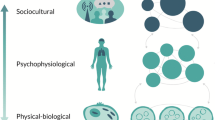Abstract
In this paper, we propose that the human brain develops a system to cover OTHER. This capital “OTHER” represents the transcendental other in infancy and the latent other later in life. The system grows to cover the transcendental other through the developmental process of objective–subjective distinction, and thereafter the latent other is found as a duality of the system later in life. To argue the emergence of such system regarding social conceptualization, we introduce experiments in which we verify that preschoolers abstract, categorize, and evaluate social relationships. The results show that children around 6 years old exhibit early social conceptualization and rudimentary objective–subjective distinction. Moreover, we claim that early social conceptualization is acquired through developing the heterarchical system when the experiments are regarded as communication between the participant and experimenter. Human beings may regard this heterarchical system as the self.





Similar content being viewed by others
Explore related subjects
Discover the latest articles and news from researchers in related subjects, suggested using machine learning.References
Piaget J, Inhelder B (1948/1956) The child’s conception of space. Routledge and Paul Kegan, London
Selman RL, Byrne DF (1974) A structural-developmental analysis of levels of role taking in middle childhood. Child Dev 45:803–806
Karmiloff-Smith A (1995) Beyond modularity: a developmental perspective on cognitive science. MIT press, Massachusetts
Gunji Y-P, Kamiura M (2003) Observational heterarchy as phenomenal computing. CRPIT’03 Selected papers from the computers and philosophy conference, vol 37. Australian Computer Society Inc., Sydney, pp 39–44
Gunji Y-P, Kamiura M (2004) Observational heterarchy enhancing active coupling. Phys D 198:74–105. doi:10.1016/j.physd.2004.08.021
Ariely D (2008) Predictably irrational. Harper Collins, New York
Csibra G, Gergely G (2009) Natural pedagogy. Trends Cognit Sci 13(4):148–153
Sonoda K, Kodama K, Gunji YP (2013) Awareness as observational heterarchy. Front Psychol 4
Davey BA, Priestley HA (2002) Introduction to lattices and order, chapter 3. Cambridge University Press, Cambridge
Acknowledgments
This work was supported by JSPS KAKENHI Grant Numbers 24118503 and 25730167, and carried out under the Cooperative Research Project Program of the Research Institute of Electrical Communication, Tohoku University.
Author information
Authors and Affiliations
Corresponding author
About this article
Cite this article
Nishiyama, Y., Kato, K., Kawasaki, K. et al. Developing a system to cover OTHER via rudimentary objective–subjective distinction. Artif Life Robotics 19, 181–185 (2014). https://doi.org/10.1007/s10015-014-0147-z
Received:
Accepted:
Published:
Issue Date:
DOI: https://doi.org/10.1007/s10015-014-0147-z




